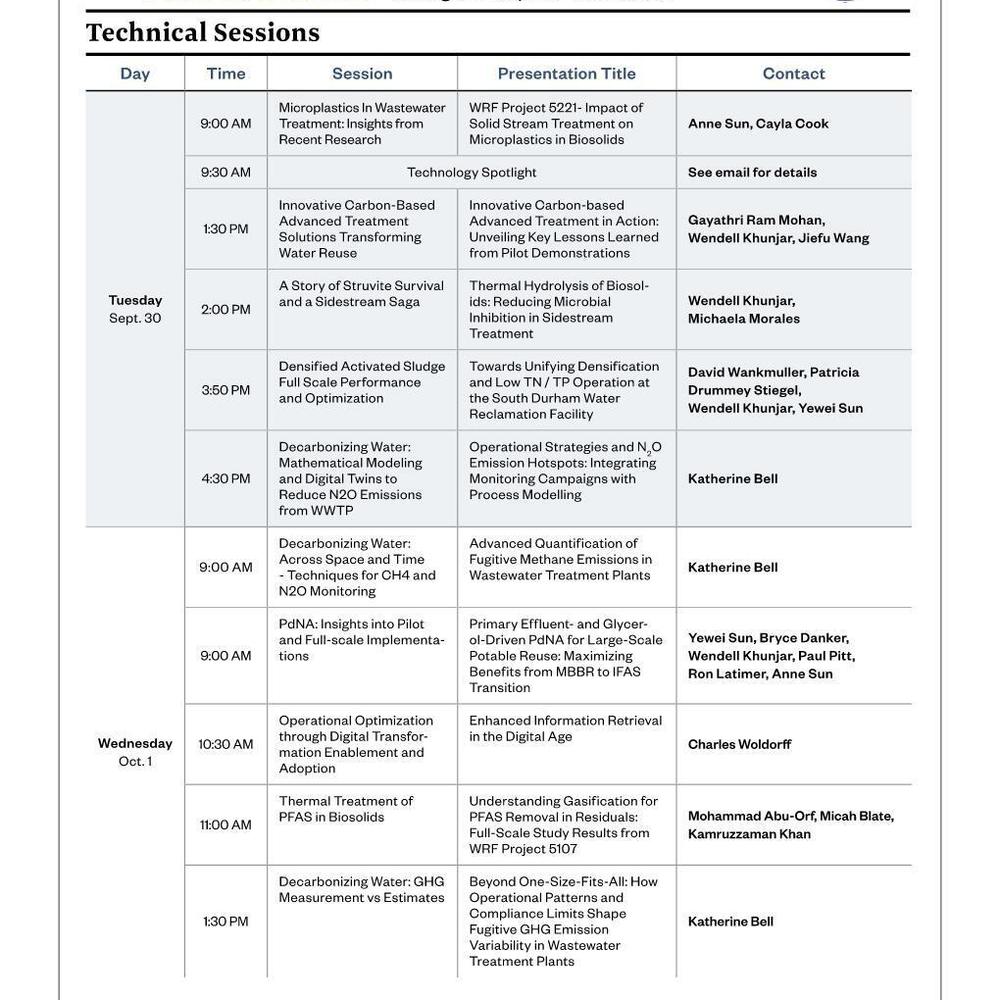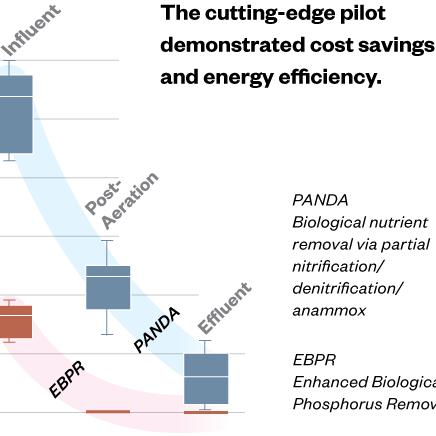Implications of THP on Sidestream Treatment Selection
Introduction
Over the past year, the City of Raleigh has developed a preliminary engineering report for a new biosolids system for its 75 mgd Neuse River Resource Recovery Facility (NRRRF) that includes: a thermal hydrolysis process (THP), anaerobic digestion, pre- and post-dewatering, and FOG receiving. Sidestream treatment of the expected higher loadings of nitrogen and phosphorus from the post-dewatered centrate was investigated as part of this study.
The purpose of this paper is to summarize key lessons learned from the sidestream treatment evaluation. The anticipated sidestream nitrogen and phosphorus loads were estimated based on a literature review, experience, and process modeling. The process model used was BioWin 4.1, and estimating RDON and RDOP in the effluent will also be addressed as part of the paper.
Sidestream Nitrogen Removal
Several sidestream deammonification treatment technologies were explored in this study, including:
- World Water Works’s DEMON®
- Veolia/Kruger’s ANITA™ Mox Moving Bed Biofilm Reactor (MBBR)
- Veolia/Kruger’s ANITA™ Mox Integrated Fixed-Film Activated Sludge (IFAS)
Based on recommendations from the manufacturers, dilution of dewatered centrate will be necessary to differing degrees depending upon the process selected. There is evidence that high chemical oxygen demand (COD) generated during the THP process is inhibitory to the ammonia oxidizing bacteria (AOB) that are required to perform nitrogen removal in the process, and that dilution of the influent concentrations ameliorates this problem. After extensive discussion with the manufacturers, the following dilution water requirements were specified:
- ANITAMox MBBR – two and a half times (2.5) the volume of dewatered centrate entering the process
- ANITAMox IFAS and DEMON– dilution water is equal to the volume of dewatered centrate entering the process (1.0)
Onsite reuse water will be used for dilution water. Deammonification systems work best at temperatures between 25 and 37°C. Without dilution water, these temperatures are easily maintained in dewatered centrate from anaerobically digested biosolids. In the winter months the temperature of the reuse water used for dilution could be as low 13°C, which would result in a process temperature significantly below the 25ºC threshold.
Calculations were performed to determine how much external heat could be generated from the THP waste heat loop to heat the dilution water in order to keep temperatures in the sidestream reactor above 25°C in the winter months. The result of this calculation was that the heat exchangers on the THP system could generate sufficient heat to raise the temperature of the dilution water to 25 – 30ºC for a volume equal to the volume of dewatered centrate. This results in the ability to heat dilution water for a 1:1 dilution using waste heat and at essentially no cost to the project. Therefore, selecting the ANITAMox IFAS or DEMON process would not have any temperature impacts on performance.
For the ANITAMox MBBR processes, options to heat the additional dilution water were explored, as were the potential impacts of not heating the remaining water. Heating the water would render the sidestream treatment option equal to or more expensive than mainstream nitrogen removal and was not pursued. The alternative and the approach utilized on this project was to accept a design with reduced nitrogen removal performance at temperatures below 25°C. This condition is anticipated to occur no more than 30 percent of the time. When nitrogen removal suffers due to low temperatures the estimated nitrogen removed is assumed to be removed in the mainstream process with methanol and associated costs were added to the evaluation.
Related Topics:

Table 1: Although capital costs are not very different among the three options, the additional dilution water required with the ANITAMox MBBR option, which lowers the temperatures below 25°C for parts of the year greatly increases the estimated operating costs, as does the additional air required for mixing.
Table 1 summarizes the anticipated capital and operating costs of each alternative and the cost per pound of nitrogen removed for each alternative based on the latest available information. The table shows that although capital costs are not very different among the three options, the additional dilution water required with the ANITAMox MBBR option, which lowers the temperatures below 25°C for parts of the year greatly increases the estimated operating costs, as does the additional air required for mixing. All three options cost less than mainstream treatment on a net present cost basis, but ANITAMox IFAS and DEMON are more competitive than ANITAMox MBBR.
Sidestream Phosphorus Removal
The NRRRF facility has the flexibility to operate its mainstream BNR process in two ways, which affect the magnitude of the sidestream phosphorus load. The first operational configuration is a 4-stage BNR mode without an anaerobic zone in service. In 4-stage mode it is most economical for the facility to utilize alum addition to meet its total phosphorus (TP) limit of 1 mg/L, and the amount of phosphorus released in the digesters will be minimal. The second operational configuration is operating in a 5-stage BNR mode with a dedicated anaerobic zone for biological phosphorus removal (BPR). When operating in 5-stage mode the quantity of orthophosphate in the dewatered centrate will be significant and there will be orthophosphate release in the pre-dewatering storage tanks when primary sludge and thickened waste activated sludge combine. Regardless of the operational configuration of the BNR basins, anaerobic digestion and the THP will increase the amount of orthophosphate in dewatered centrate in both configurations albeit to differing degrees.

Table 2: A cost comparison of the options discussed in the paper.
A cost comparison was prepared and is summarized in Table 2. It is recommended that the City initially start with chemical phosphorus removal but reevaluate the financial situation once the THP system is operating since resource recovery is a sustainable endeavor. More detail on this evaluation including the factors that favorably sway the economics in favor of a resource recovery solution (an increase in struvite product value, a decrease in magnesium chloride cost, a decrease in supplemental carbon costs, and an increase in alum costs) will be provided in the paper.











